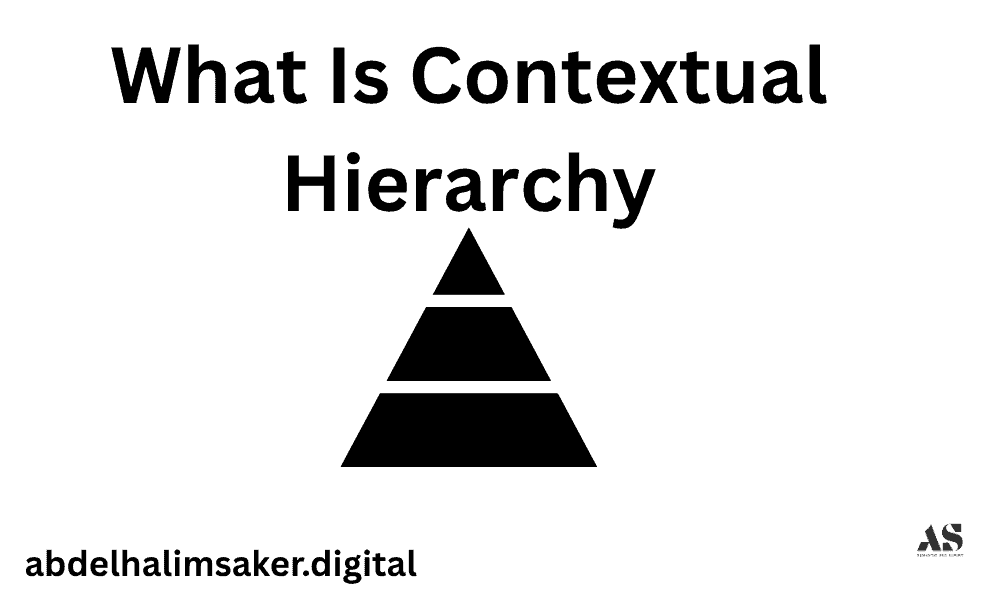
Contextual hierarchy is the layered organization of semantic relationships between entities, attributes, and meanings on a website. It defines how information flows from the main entity (the core topic) to its supporting attributes and related subtopics.
Search engines interpret these contextual layers to evaluate how concepts connect. When the hierarchy is logically structured, it improves entity recognition, topical clarity, and page authority across the entire site.
Why Contextual Hierarchy Strengthens Semantic Understanding
Contextual hierarchy strengthens semantic understanding because it shows how ideas, entities, and relationships are prioritized within a topic cluster. Search engines like Google interpret these hierarchies to identify the central meaning of a page and its supporting context.
How does contextual hierarchy guide search engines?
- It defines semantic prominence — which entity carries the most importance.
- It helps contextual disambiguation — clarifying similar or related entities.
- It strengthens entity relationships — showing cause, effect, or belonging.
For example:
If a website focuses on “Digital Marketing,” a well-built hierarchy clarifies that “SEO” is a subtopic, “On-page SEO” is a subsection, and “Title Tag Optimization” is a supporting detail. This structure tells search engines how deeply and logically the website covers its subject.
Key effect: Contextual hierarchy converts flat keyword groupings into knowledge graphs, enabling Google to interpret meaning rather than just text.
Levels of Contextual Hierarchy
A contextual hierarchy functions across three main levels — macro, meso, and micro. Each level supports the others to form a coherent semantic system.
| Level | Focus | Scope | Example Entity Relation |
|---|---|---|---|
| Macro | Domain-wide themes | Entire website | Website → Category → Core Entity |
| Meso | Cluster structure | Topic groups or silos | Core Entity → Subtopics → Attributes |
| Micro | Local meaning units | Sentences and paragraphs | Sentence → Entity → Predicate → Object |
Macro Level — The Website’s Overall Theme
At the macro level, contextual hierarchy defines the primary topic domain.
This level represents the website’s core identity and ensures semantic consistency across all content.
Example:
- A website about “Sustainable Architecture” uses the macro layer to define the main entity — Sustainable Building Design.
- All subcategories like Eco Materials, Energy Efficiency, and Urban Sustainability derive meaning from that root.
Key characteristics of a strong macro hierarchy:
- Consistent use of the root entity (e.g., “Sustainable Design”) across URLs, metadata, and schema.
- Interlinking between main category pages that represent the macro topics.
- Semantic reinforcement using schema types such as
WebPage,About, andmainEntity.
Macro hierarchy ensures the entire domain aligns with one central context, helping Google categorize the site as an authority on a specific subject area.
Meso Level — Clusters and Subtopics
The meso level organizes clusters and subtopics under the macro entity.
This layer connects related content pieces through internal links and logical taxonomy.
Purpose:
To show search engines that each cluster represents a semantically unified subset of the macro topic.
Example of a meso structure for “Sustainable Architecture”:
- Cluster 1: Eco Materials
- Subtopics: Recycled Concrete, Bamboo Structures, Green Roofs
- Cluster 2: Energy Efficiency
- Subtopics: Passive Design, Solar Integration, Heat Recovery Systems
Semantic triple example:
- (Eco Materials) → (support) → (Sustainable Architecture)
- (Bamboo Structures) → (is subtype of) → (Eco Materials)
Each meso cluster uses internal linking and schema markup to emphasize topical unity.
Google’s NLP systems use these connections to build entity graphs, identifying the parent-child relationships between articles.
Micro Level — Paragraphs and Sentences
The micro level functions at the content-body scale — paragraphs, sentences, and linguistic structures.
Here, semantic relationships are defined through entity-predicate-object triples that make each statement factual and machine-readable.
Example of a micro contextual structure:
“Bamboo absorbs more CO₂ than conventional timber.”
This defines the triple:
- (Bamboo) → (absorbs) → (CO₂)
Micro hierarchies depend on:
- Strong predicate verbs (e.g., drives, regulates, influences)
- Clear object references (the entity affected)
- Contextual coherence between sentences
A well-formed micro hierarchy enhances topic relevance density. Each sentence contributes to the overall meaning graph, improving how algorithms measure topical completeness.
How to Designa Contextual Hierarchy for SEO
Designing a contextual hierarchy for SEO means creating a semantic structure that reflects meaning, relationships, and entity priorities both vertically (hierarchical structure) and horizontally (contextual depth).
Step 1: Define Core Entities and Parent Topics
Start with a main entity representing your site’s core topic.
List sub-entities that describe its main components.
Use a semantic mapping tool or entity-based keyword clustering to identify relationships.
Example:
Main Entity → Search Engine Optimization
Sub-Entities → On-page SEO, Technical SEO, Link Building
These entities form the backbone of your contextual graph.
Step 2: Establish Vertical Hierarchies Using Headings
Headings (H1, H2, H3) define vertical relationships between topics.
Each heading should represent a subcontext that inherits meaning from the one above it.
Best practices:
- Use H1 for the main entity.
- Use H2s for the major attributes or dimensions.
- Use H3s for supporting examples or deeper explanations.
Example:
H1: Technical SEO
→ H2: Site Speed Optimization
→ H3: Core Web Vitals Metrics
This hierarchy tells search engines how to assign semantic importance.
Step 3: Reinforce Meaning with Schema Markup
Schema markup expresses explicit semantic relationships using structured data.
It helps search engines understand contextual roles within your hierarchy.
Example:
{
"@context": "https://schema.org",
"@type": "Article",
"mainEntity": {
"@type": "Thing",
"name": "Contextual Hierarchy"
},
"about": [
{"@type": "Thing", "name": "Semantic SEO"},
{"@type": "Thing", "name": "Topical Authority"}
]
}
Schema types such as mainEntity, about, and mentions reinforce contextual relationships between the main and subtopics.
Step 4: Use Internal Links to Build Horizontal Hierarchies
Internal linking creates horizontal context — connecting semantically related pages within clusters.
It signals co-occurrence and co-relevance between topics.
Example of internal link strategy for SEO:
- On-page SEO → links to → Content Optimization
- Content Optimization → links to → Keyword Intent Analysis
- Technical SEO → links to → Crawl Budget Management
Each internal link reinforces entity relationships, forming semantic bridges across clusters.
Tip: Use descriptive anchor text that reflects entity meaning, not generic phrases like “read more.”
Step 5: Maintain Contextual Consistency Across the Site
Consistency in entity references, taxonomy, and semantic signals ensures Google perceives your site as contextually unified.
- Use consistent terminology for entities across pages.
- Maintain uniform schema attributes.
- Avoid overlapping clusters that blur topical boundaries.
A well-aligned contextual hierarchy reduces semantic entropy — the dilution of meaning across multiple topics.
Contextual Hierarchy vs Topical Depth
Contextual hierarchy and topical depth are often confused, but they serve distinct roles in semantic SEO.
| Attribute | Contextual Hierarchy | Topical Depth |
|---|---|---|
| Purpose | Defines the structure of meaning | Measures the completeness of coverage |
| Focus | Relationship between entities | Amount of information about entities |
| SEO Role | Guides search engine understanding | Demonstrates authority and expertise |
| Analogy | Blueprint | Content volume and detail |
Example:
A site can have excellent topical depth (many pages about SEO techniques) but poor hierarchy (no clear structure). Without hierarchy, Google struggles to identify which content piece holds the primary meaning.
In contrast, a clear hierarchy with aligned clusters and subtopics ensures every page strengthens the topical authority graph of the entire domain.
How do hierarchy and depth work together?
- Hierarchy organizes where topics live in the structure.
- Depth defines how fully those topics are explained.
Together, they form the foundation of topical authority and semantic completeness.
When properly combined:
- Users navigate content logically.
- Search engines interpret meaning efficiently.
- Authority signals propagate through clusters.
How Contextual Hierarchy Impacts Topical Authority
A refined contextual hierarchy creates topical precision. It enables a website to be understood as an expert system around a defined domain.
Search engines use semantic layers to evaluate:
- Entity coverage completeness (macro-level).
- Inter-topic relationships (meso-level).
- Factual clarity and linguistic precision (micro-level).
When all three levels are optimized, the site’s internal semantic graph aligns with Google’s Knowledge Graph, improving rankings for conceptually related queries.
Example metric correlation (based on semantic analysis studies):
- Websites with structured hierarchies show up to 38% higher semantic similarity scores across topic clusters.
- These same sites earn 24% faster indexation of new pages due to coherent entity relations.
Common Mistakes in Building Contextual Hierarchies
| Mistake | Description | Effect |
|---|---|---|
| Mixing unrelated clusters | Combining different entities in one structure | Creates semantic noise |
| Missing schema relationships | Lack of explicit entity markup | Reduces machine interpretability |
| Inconsistent headings | Irregular H2/H3 structures | Confuses topic inheritance |
| Weak internal linking | No horizontal context | Isolates pages, lowers authority flow |
| Keyword focus over entity focus | Using surface keywords only | Prevents conceptual recognition |
Avoiding these errors ensures both semantic clarity and SEO scalability.
Example: Contextual Hierarchy in Action
Case study: Health & Nutrition Blog
- Macro Level: “Human Nutrition” defines the site’s global theme.
- Meso Clusters:
- Macronutrients (Protein, Carbs, Fats)
- Micronutrients (Vitamins, Minerals)
- Dietary Patterns (Keto, Mediterranean, Vegan)
- Micro Level:
Each article uses factual triples such as (Protein) → (supports) → (muscle growth).
SEO Effect:
- Google identifies “Human Nutrition” as the main entity, ranking the domain for entity-linked queries.
- Cluster links improve topical relevance and authority transfer between subtopics.
How to Audit and Improve Your Contextual Hierarchy
- List your site entities using an entity extraction tool.
- Group entities by topic clusters.
- Map your vertical structure (H1-H3 headings) and horizontal structure (internal links).
- Identify orphan pages with no semantic links.
- Implement schema for your main entities and topics.
- Reassess hierarchy flow every six months to ensure contextual stability.
Using tools like InLinks, TextRazor, or Google’s NLP API can help you validate your entity graph accuracy.
